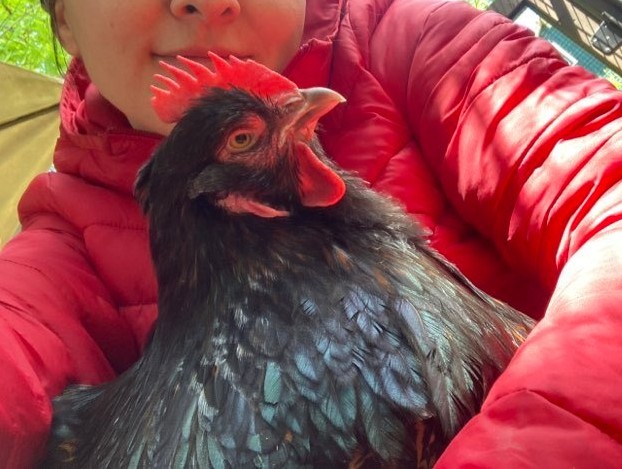Chickens, often seen simply as egg-laying or meat-producing farm animals, are actually intelligent creatures with intricate social lives. Many people who are new to keeping chickens wonder, “Can You Pet Chickens?” The answer isn’t always straightforward, and it touches upon understanding chicken behavior, preferences, and how they interact with humans. This article will explore whether chickens enjoy being petted, how to approach them, and what their reactions might mean. By diving into the social dynamics of chickens, we can better appreciate these fascinating birds and learn the best ways to interact with them.
Chickens are highly social animals, organizing themselves into flocks with established hierarchies. Within these flocks, they communicate in complex ways, using vocalizations, body language, and physical interactions. Observing a content and relaxed chicken, you might notice soft clucking sounds, and perhaps even closed eyes as they seem to enjoy gentle stroking from a fellow chicken. These social cues are vital in understanding how chickens interact with each other and how they might perceive human touch. A relaxed chicken often displays fluffed feathers and wings held slightly away from its body. Conversely, a stressed or threatened chicken will hold its wings tightly and keep its feathers flat.
So, circling back to the main question: do chickens like to be petted? The truth is, it varies. There’s no universal “yes” or “no”. Whether a chicken enjoys being petted depends largely on the individual bird and its unique personality. Just like humans, some chickens are naturally more sociable and enjoy interaction with people, while others are more reserved and prefer their own space.
However, there are strategies to increase the chances that a chicken will enjoy being petted. The most important first step is to approach chickens slowly and calmly. Quick movements and loud sounds can easily frighten them, triggering their natural fear response. Before attempting to touch a chicken, allow it to see your hand and approach at its own pace. This gives the chicken a moment to assess you and the situation, and to decide if it wants to engage.
When you do make contact, gentleness is key. Avoid grabbing or squeezing a chicken, as this can be very uncomfortable or even painful for them. Instead, use a soft touch, stroking their feathers in the direction they naturally lie. Many chickens seem to enjoy being petted on their backs, gently under their wings, or even under their chins.
It’s crucial to continuously monitor a chicken’s body language while petting it. If a chicken appears uneasy, tries to move away, or shows signs of stress like দ্রুত breathing or tense posture, it’s important to respect its boundaries. In such cases, it’s best to give the chicken space and perhaps try again at another time when it might be more receptive.
Another significant factor influencing a chicken’s receptiveness to petting is trust. Chickens raised in a nurturing and caring environment are far more likely to develop trust in humans and, consequently, enjoy being petted. On the other hand, chickens that have had negative experiences with humans may be more fearful and less inclined to enjoy physical contact. Building a positive relationship through consistent gentle interactions and positive reinforcement can greatly enhance a chicken’s comfort level with human touch.
Do Roosters Enjoy Petting?
The same principles apply to roosters as to hens when it comes to petting. Whether a rooster likes to be petted is highly individual and depends on its personality and past experiences. Some roosters might appreciate being petted, while others may be more standoffish and prefer not to be touched. However, it’s especially important to exercise caution when approaching roosters, as they can be more protective and potentially aggressive than hens. Roosters possess sharp spurs on their legs, which they can use for defense if they feel threatened. Be acutely aware of rooster body language. Signs of agitation include puffed-up feathers, fanned tails, and loud vocalizations. These are clear indicators that the rooster is uncomfortable or feels threatened.
If you wish to attempt to pet a rooster, always approach slowly and calmly, allowing him to see your hand and movements. Gentle touch is even more critical with roosters. Avoid any sudden grabs or tight holds. Some roosters might tolerate or even enjoy gentle petting on their back or chest, but many may prefer to be admired from a distance.
Building trust is paramount with roosters. Spending time near them, offering treats, and speaking softly can help foster a positive relationship. This gradual trust-building approach is key to increasing a rooster’s comfort around humans and potentially making petting a more pleasant experience for both of you. Always prioritize the rooster’s comfort and back off if he shows any signs of stress or aggression.
Understanding Chicken Squatting Behavior During Petting
A common behavior that can be misinterpreted is squatting. When a chicken squats or crouches down as you approach or pet it, this is actually a sign of submission, often referred to as a “submissive squat.” In their natural flock dynamics, hens squat to allow a rooster to mount them for mating. However, when a chicken squats as you pet it, it’s not an invitation for mating with you! Instead, it’s a sign of trust and comfort in your presence.
When a chicken squats, its body posture changes noticeably. It lowers its head and tail and tucks its wings in close to its body. This posture makes them more vulnerable, so a chicken will only adopt this position when it feels safe and trusts the individual approaching it.
It’s important to remember that not all chickens will squat when approached, even if they are comfortable with you. Some chickens might prefer to be petted while standing, while others may simply not enjoy being touched at all. Squatting is a positive indicator of trust and a potential sign of a strong bond between you and your chicken, but its absence doesn’t necessarily mean the chicken is unhappy or doesn’t trust you.
Can Chickens Show Affection Towards Humans?
Chickens are indeed capable of forming bonds with their human caretakers and demonstrating affection, although it might look different from how cats or dogs show it. Chickens express affection through various behaviors that indicate they like and trust their humans. One common way is by simply following their favorite person around. Chickens are naturally curious and love to explore, but a chicken that has bonded with its caretaker might choose to stay close and follow them instead of wandering off independently.
Chickens might also seek out their human for attention, especially if they associate you with positive experiences like treats or gentle interactions. They may come running towards you when they see you approaching and may make soft, happy vocalizations when being petted or offered treats.
Social grooming is another way chickens might show affection. Chickens enjoy being preened by other chickens, and they might extend this behavior to their human caretakers. Allowing you to gently stroke their feathers or even preen them is a significant sign of trust and comfort.
It’s important to understand that each chicken is an individual. Not all chickens will express affection in the same ways. Some might be more reserved, preferring a bit more distance, while others are more outgoing and enjoy closer interactions. Building a positive relationship with a chicken takes time, patience, and consistent gentle care. However, with attention and understanding, it’s definitely possible to form a meaningful bond with these intelligent and engaging birds.
Conclusion
Chickens are complex social animals with diverse behaviors and communication methods. Whether or not chickens enjoy being petted is not a simple yes or no question; it depends on their individual personalities, experiences, and how humans approach them. By learning to understand chicken body language, approaching them calmly and gently, and respecting their boundaries, we can increase the likelihood of positive petting interactions. Petting a chicken, when welcomed, can be a mutually rewarding experience. It offers a unique opportunity to bond with these often-misunderstood creatures and appreciate their individual personalities.
Do you enjoy petting your chickens? Share your experiences and photos in the comments below!

